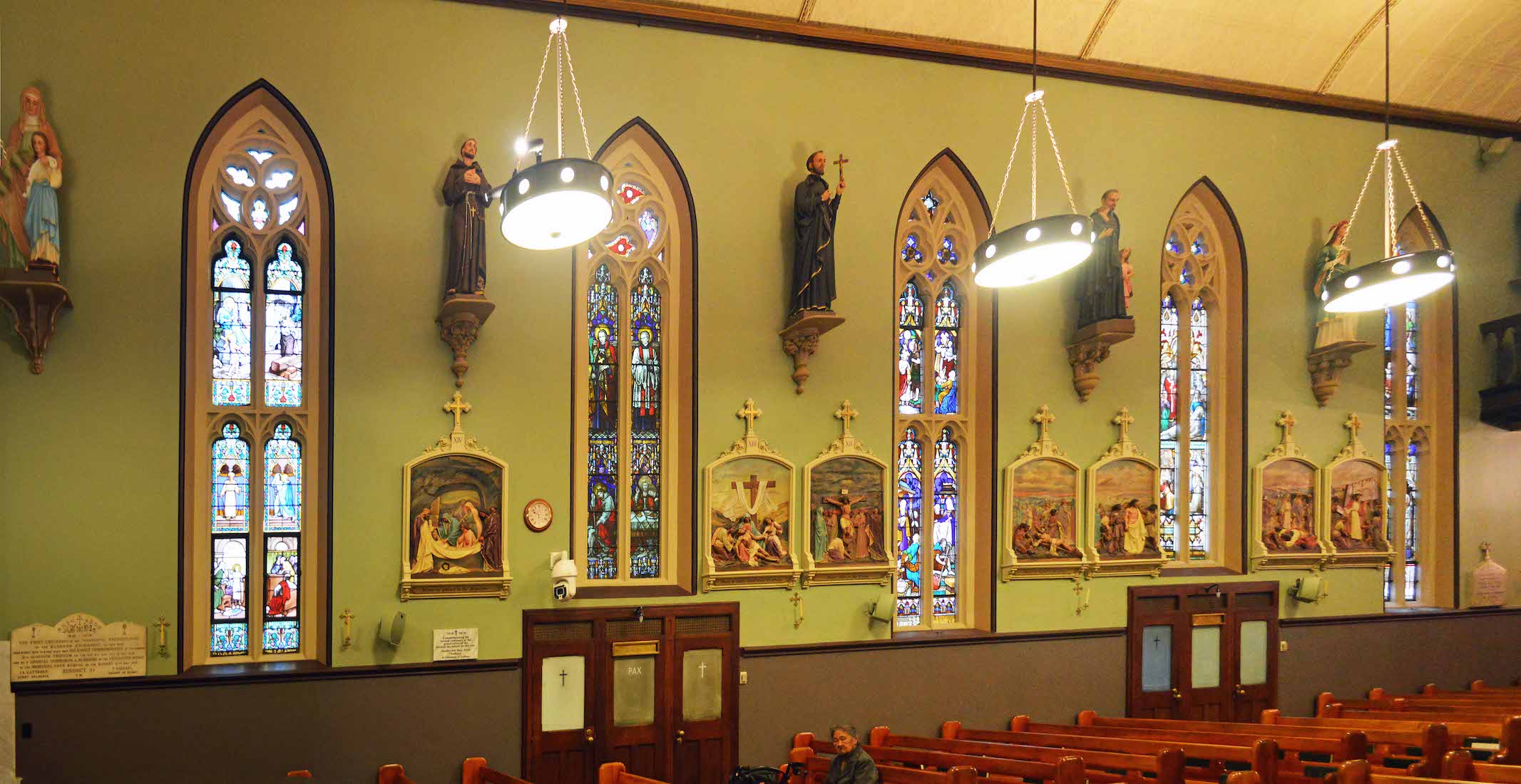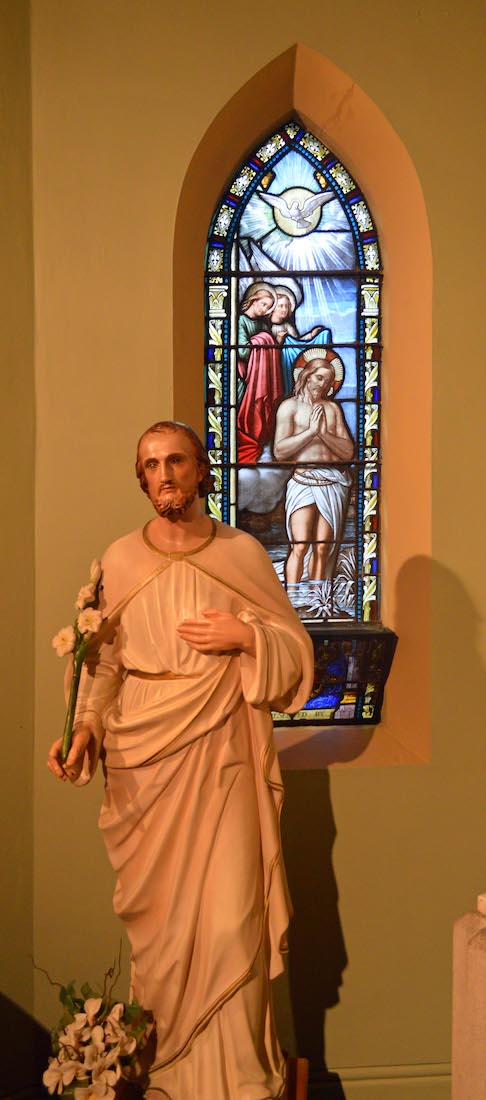
We take the tram up George Street, alight at the Wynyard stop, and walk a short distance eastwards along (up!) Grosvenor Street. St Patrick’s Church is on our right, opposite the sloping Lang Park. The Church looks attractive in its leafy surrounds, but is now rather lost amidst the Sydney high-rise. INDEX
2. WEST WALL


The West wall has a single gable with a small octagonal tower and spire on either side. The style is Gothic with an abundance of pointed arches on this wall: three central windows, three niches, each containing a statue, and three doors including the central main entry. We notice a couple of round plaques on the right hand side.
3. NORTHWEST VIEW
The North wall abuts the footpath of Gloucester Street, with a sequence of Gothic stained glass windows alternating with small capped buttresses.
4. WEST WALL STATUES
There are three niches on the Western wall, each containing the statue of a saint. No labels are apparent, but one might assume that the central figure is St Patrick?
5. WEST WALL PLAQUES
The plaque at left celebrates the laying of the 1840 foundation stone by the Most Reverend John Bede Polding. ••• The green plaque at right was one of 101 commemorative plaques installed between 1984 and 1988 by RAHS (The Royal Australian Historical Society).
6. WEST WALL SIDE DOOR
The side doors on the West wall have a simple Gothic shape, and relatively unadorned surrounds. The decorative front arches end in unidentified heads – a common practice with old church buildings.
7. WEST DOOR
The central West door has a more richly decorated arch, and the unidentified heads are of a more elevated rank! The door leads through to a small entry foyer which we shall shortly enter.
8. NORTH SIDE
Bur first we take a look down the North wall. As mentioned earlier, the wall is made up of stained glass windows with alternating capped buttresses. It is clearthat some of the stone work has been replaced over the years – unfortunately with no effort being made to match the new with the old. The windows, like the Western doors, have simple decorative arches ending in unidentified heads. A wrought iron fence protects the Church from passing pedestrian traffic, and allows some light down into the crypt.
10. WIDER VIEW OF NAVE
Here is a wider panoramic view. There are in fact seven stained glass windows along each side. Between each pair of windows is a stretch of wall bearing colourful Stations of the Cross, and above, the statue of a saintly figure, standing on a pedestal. At ground level there are several recessed confessionals.
11. SIDE CHAPEL
Before we begin exploring the nave, we look at the little side chapel on our immediate left. Facing us is a framed picture of the crowned St Mary holding the Christ Child. On the altar below are vases of flowers, a small St Patrick, and a copy of the Prague Christ Child statue. On either side of the altar is a life-sized figure, standing in front of a small stained glass window. This is obviously a place for prayer and lighting of candles.
12. STATUES AND WINDOWS
The two saints stand before windows depicting the baptism of Jesus and St John the Baptist, indicating that this little chapel was originally the Church baptistry. We shall later find the baptismal font has been relocated inside the Church itself. The figure shown at left is St Joseph. He is often depicted carrying a flowering sprig, alluding to an old legend about him becoming the spouse of the Mother of Jesus. The figure at right is St Stanislaus Kostka (1550 – 1568), a Polish novice of the Society of Jesus who was known for his youthful holiness and iron determination to follow God’s call despite family obstacles.
13. THE MADONNA AND ST MARY OF THE CROSS
On closer inspection we see that the framed Madonna and Child is in fact a mosaic. The framed icon we pass on leaving the side chapel is of Australian saint, St Mary of the Cross. Mary MacKillop (1842 – 1909) was beatified in 1995 by Pope John Paul II, and is the first Australian to be recognised by the Catholic Church as a saint.
14. NAVE SOUTH WALL
Having left the side chapel, we will now investigate the features of the side walls of the Church. We notice along this wall (and in fact both walls) tiny gold crosses with a candle attached to each. These are consecration crosses, showing where the bishop anointed the Church with chrism or holy water to consecrate it. We also observe that there are seven stained glass windows along this wall.
15. SOUTH WALL FROM THE EAST

At several places around the bases of the walls are sets of three doors. These are confessionals where members of the congregation can confess their sins to a priest. We notice that the stained glass windows above the doors are shorter than the others..
16. NORTH WALL  There are seven stained glass windows along this North wall too, with one not shown at extreme right. Both nave walls have a repeated regularity, with the windows separated by wall panels featuring a saint at the top, and, with the exception of the end panels, one or two stations of the cross below. As is customary, the 14 stations of the cross begin near the Northeast corner and follow around the nave in an anticlockwise direction.
There are seven stained glass windows along this North wall too, with one not shown at extreme right. Both nave walls have a repeated regularity, with the windows separated by wall panels featuring a saint at the top, and, with the exception of the end panels, one or two stations of the cross below. As is customary, the 14 stations of the cross begin near the Northeast corner and follow around the nave in an anticlockwise direction.
17. STATIONS OF THE CROSS
The first three stations of the cross are shown here. The stations act as an aid to meditation, particularly around Easter time, as they follow the journey of Jesus to the Cross. A complete set of the stations of the cross at St Patrick’s Church can be seen here.
18. WALL PANELS
Here are two of the wall panels on the North wall of the Church which feature a saint and one or more stations of the cross. You can view all the wall panels of this type by clicking / tapping here. The order is the same as that of the stations of the cross.
19. WALL SAINTS
As we have seen, there are a number of saints around the walls of the nave. You can see them in order by clicking / tapping here.
20. NORTH WINDOW 7
We now look at the nave windows, beginning in the Northeast corner (by the Sacred Heart shrine). For reference, the windows on either side of the nave are numbered from 1 to 7, starting from the Western balcony end. The central feature of this window shows the origin of the Devotion of the Sacred Heart. It appears that a Roman Catholic nun from France, Margaret Mary Alacoque, learned the devotion from Jesus during a series of apparitions to her between 1673 and 1675. The flaming heart represents the ardent love of Christ.


























